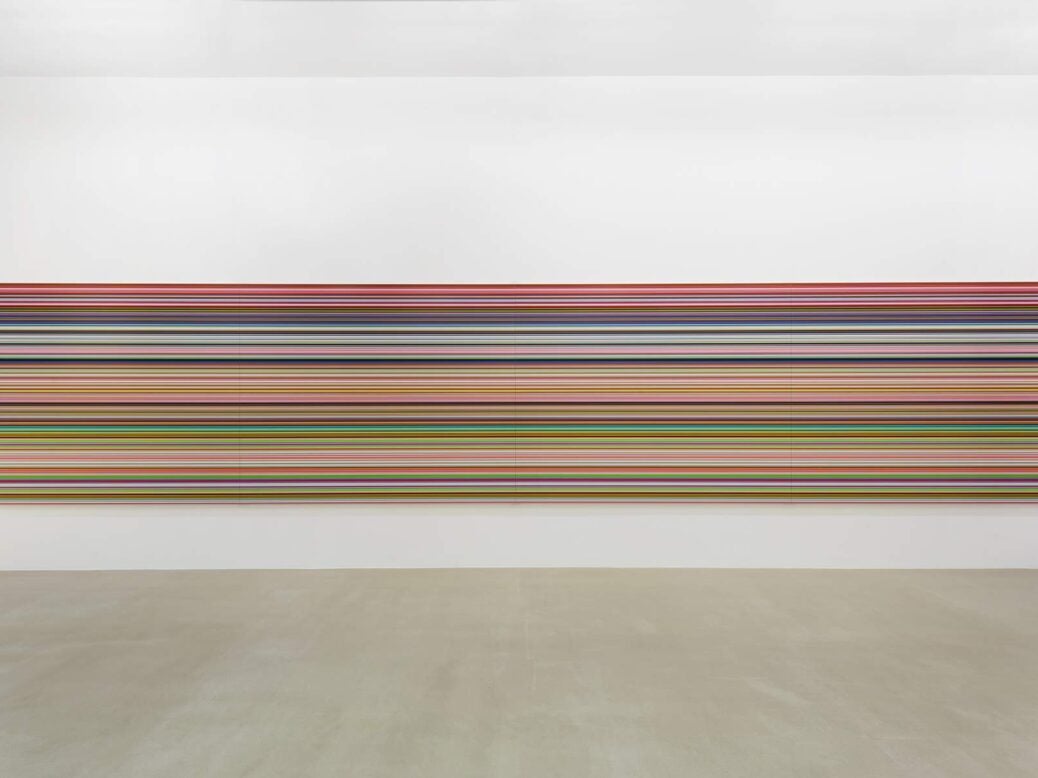
Sol LeWitt, Gabriel Orozco, Ettore Spalletti, Niele Toroni and Gerhard Richter delight at the Marian Goodman Gallery (once you get past the awful title), writes Christopher Jackson
Gerhard Richter, 930-6 Strip, 2013-2016, Digital print on paper mounted between Alu Dibond and Perspex (Diasec) (200x1000cm)
The first duty of viewers at this exhibition is to see past the rich embarrassments of its title – The supreme rifts… a measured propinquity. It is a banner so pretentious that it can still make one pause and shake one’s head even hours later. Never has an ellipsis grated so much and accomplished so little.
The title was dreamed up by Michael Newman, Professor of Art Writing at Goldsmith’s University, and he also contributes an accompanying essay on the epiphany which led him to commit this linguistic atrocity – and along the way perpetrates many other absurdities in C minus prose. I would be happier if you didn’t read it.
Of course, you haven’t come to Spear’s for a rant, and besides it would be unfair to the artists involved because once you have cast aside his essay (and banished the preposterous title from your mind), there’s much to enjoy here: a rose by any other name would smell as sweet.
This is, in fact, a beautifully laid out show which includes the works of at least two first-rate artists. There is Gerhard Richter, whose fame has been assured ever since his 2005 retrospective at the Goodman’s New York gallery – he is one of the known facts of the artistic stratosphere, and doesn’t disappoint here. More on him later.
Ettore Spalletti, Mezzanotte, blu, tuttotondo, 2016, Color impasto on board, (200 x 200 x 4cm) (left); Passagio, 15, 2016 (78 ¾ x 78 ¾ x 1 9/16 in. (200 x 200 x 4cm) (centre); Mezzanotte, blu, 2016, Color impasto on board, gold leaf (200 x 200 x 4cm) (right).
Then there is Ettore Spaletti, whose most prominent works here are a series of color impastos on board, one fringed on its right side with gold leaf. Reminiscent of Agnes Martin at first, on closer acquaintance they turn out to have a powdery lushness all their own. Apparently our limit for minimalism has not yet been reached. In Piet Mondrian and Ben Nicholson, their rigor was linked to escapism from the horrors of the twentieth century; in Spaletti, the impression is of sensuous immersion in the sort of blue we have all sometimes gazed on mid-flight as the departing plane rushes on out of cloud.
Sol Lewitt is given a large room in the upper gallery. His wall drawings show geometric shapes tilting and rolling along warmly coloured walls. These – stringent and disciplined though they are – cheer the heart with their partying colours, and sense of outsized fun. They are dice in a happy casino.
Sol Lewitt, Wall Drawings, 1988.
But though he has only three works on display here, the day belongs to Richter. The main picture – his 930-6 Strip (see top of this article) – is a digital print on paper mounted between Alu Dibon and Perspex. It is an ambitious panel: a stretched tautness of colours which as you walk through the supermarket light of the gallery, can sometimes seem to enlarge itself alarmingly. It doesn’t give pleasure, only a certain unease. One is never sure whether it would be quite so concerning under softer lighting, or whether the confusion is intrinsic to the work itself.
Richter’s art is the triumph of strictness. One might think that his Mirror, Grey (739-2), 1991 – which is exactly as it sounds, a greyness in which one can see oneself – ought to be too simple to be interesting. But instead one seems to watch oneself enter the sombre reflectiveness of a sacred space. It might be austere, but it insists on itself sufficiently to make you think. Likewise, Richter’s 6 Panes of Glass in a Rack displays a sonneteer’s tightness of form: one simply accepts that the piece needs to be this way, criss-crossed with steel wires, the panels ranged in simple lines. It is a thing done for its own sake: like all good art, it invites not comment, but acquiescence.
And so one walks out into the Soho night, happy to have seen this show, but wishing it had been called something else and the paintings left to speak for themselves.
The supreme rifts… a measured propinquity runs until 8 April 2017 at the Marian Goodman Gallery
Christopher Jackson is Head of the Spear’s Research Unit









